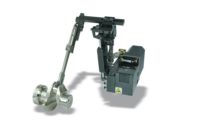
Photo: The L.S. Starrett Co.
For years, conventional analog meters have been capable of reading extremely small dimensions. But new benchtop gage technology brings both analog and digital amplifying capabilities to an easy-to-use, advanced level.
Benchtop gages, available in several models-one for analog-type linear variable displacement transducer (LVDT) probes and another for new long-range digital types-give inspectors the capability to measure with multiple probes.
More fixturing options
Benchtop gaging solutions can be used with dedicated inspection fixtures designed for a specific measuring application. They take up less work space than multiple electronic indicators or readout devices and can deliver large amounts of information on one viewing screen.
Making the decision to use dedicated fixture gaging rather than individual inspection devices is not an easy one. Although initial investment may seem costly, with sufficient volume, fixture gaging can be justified because it reduces inspection labor and training. With temporary labor becoming more prevalent, eliminating the time it takes to instruct an operator on how to read a micrometer or indicator is a big plus.
Training with these new benchtop gages is minimal. Inspectors orient the part in a fixture, view a value and, if required, press a print button. Benchtop gages with three-color displays allow inspectors to make quick, easy decisions on part quality. Units with built-in relay connections can mechanically reject out-of-tolerance parts.
The technology
Go/no-go gaging may seem like old technology, but add the power of probing combined with a microprocessor and capabilities increase significantly. A typical example might involve a LVDT probe that contacts a part and measures the variance from a perfect part.
The most simple go/no-go gages have digital readout displays or columns that provide a direct reading of the values from the probe. The more sophisticated systems for fixture gaging are computer-based, require skilled operators and are costly to run and maintain. Newer benchtop gages have a microprocessor-based display that is simple to read.
One advanced gage amplifier displays the number value of the part being measured and provides visual and audio clues when parts fail. Its highly visible, intuitive and familiar interface with standard color cues instantly informs operators of pass or fail performance details. In addition, a relay connection can be programmed to open and close if certain conditions are met, providing instant feedback when dimensions are out of tolerance.
With these gages, direct probe outputs can be algebraically and mathematically combined for dimensions such as thickness, flatness, dwell angles and maximum tip heights. Results can be displayed numerically, graphically or archived for process studies such as simple statistical process control. Trigonometric formulas convert linear measurements into angular measurements. Other formulas also can be created for total indicator runout, volume and angles between camshaft lobes.
When using a display device, it's important to have access to external interfaces. Some units provide connectivity to PCs and other devices for data collection, printouts reports and other documentation requirements. Statistical process control functions also are integrated into the device so operators can ensure that a process is corrected before out-of-tolerance parts are manufactured.
An advanced multi-function gage amplifier for fixture gaging can quickly assure the quality of a product. It is easy to operate, and its powerful and flexible microprocessor offers a wide range of gaging solutions for many manufacturing applications.
